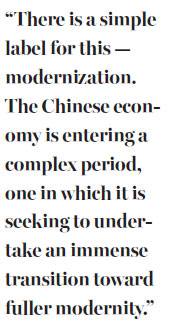On right track for quality development
Updated: 2016-02-26 08:57
By Kerry Brown(China Daily Europe)
|
|||||||||
It's right to be vigilant, but the world needs to start thinking about the real issues of Chinese growth
The surprising thing now is not that the Chinese economy is slowing, but that there are so many who seem surprised by this.
Chinese leaders, and economists, have been saying for years that the high rate of GDP growth was unsustainable. In many ways it is remarkable that China has managed it as long as it has.
From 1978 to the 2000s, the Chinese economy grew fast, but from a much smaller base. Delivering 10-plus percent GDP increases was easier then than now, for the simple fact that these days the Chinese economy is five times larger than it was even as recently as 2000. Producing 1 percent of growth means much more activity and work now than it did a decade and a half ago.

On top of this is the simple issue of the inevitable change to the economic structure as a country develops. In the early and middle phase of reform and opening-up, China remained a place where more than half its people lived in rural areas, and it had a high dependence on manufacturing for exports and fixed-asset investment. All of this added up to a colossal commitment to the future, with high amounts of economic activity aimed at improving infrastructure and human capital, things which China now has in place.
China is moving beyond that investment phase now. It is, to put it simply, maturing.
Bearing all this in mind, it is time to think of China as more than a place that can be summarized on the basis of a single GDP statistic. We need to look at the increase in services as a proportion of GDP, up 8 percent in terms of growth over the last year, and consumption, which has risen in the past two years from 36 percent of GDP to 38 percent. We need to look at the diversification of China's energy consumption, which is shifting away from coal toward other forms of supply - and the ways in which wages are rising for the all-important emerging middle class, making them different economic actors.

There is a simple label for this - modernization. The Chinese economy is entering a complex period, one in which it is seeking to undertake an immense transition toward fuller modernity. Again, like the deceleration of raw GDP growth, this has been repeatedly referred to by Chinese officials over the past five years. The mission in their words is clearly to deliver a higher-consuming, more innovative, more diverse, more domestically focused growth model - one in which China is less the factory of the world and more an intellectual center in its own right, using the assets, for instance, of its 2,500 universities to create deeper linkages and more-balanced, research-led partnerships with the world, creating a modern healthcare system, modern cities, and an indigenous finance sector.
There remain plenty of sources of growth in China. But the story of growth in China now has to be about quality. Quality in terms of environmental sustainability, in terms of meeting the aspirations for a better standard of living among Chinese people, and in terms of creating a properly modern, innovative and entrepreneurial model.
This is not something to be optimistic or pessimistic about. There isn't any alternative. It is right to be vigilant and show concern, but the outside world, when it comes to Chinese growth, needs to stop panicking about the easy figures and start thinking about the real issues - how China's transition toward developed economic status was always going to be tough, and how, as long as the will inside and outside China is there, anything is possible.
The author, a former British diplomat stationed in Beijing, is director of the Lau China Institute and professor of Chinese studies at King's College, London, and an associate of Chatham House. The views do not necessarily reflect those of China Daily.
Today's Top News
Inspectors to cover all of military
Britons embrace 'Super Thursday' elections
Campaign spreads Chinese cooking in the UK
Trump to aim all guns at Hillary Clinton
Labour set to take London after bitter campaign
Labour candidate favourite for London mayor
Fossil footprints bring dinosaurs to life
Buffett optimistic on China's economic transition
Hot Topics
Lunar probe , China growth forecasts, Emission rules get tougher, China seen through 'colored lens', International board,
Editor's Picks

|

|

|

|

|

|







